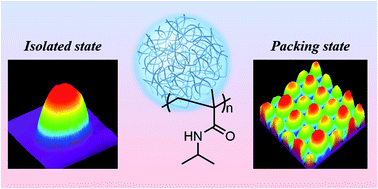Nanostructure and thermoresponsiveness of poly(N-isopropyl methacrylamide)-based hydrogel microspheres prepared via aqueous free radical precipitation polymerization†
Abstract
Thermoresponsive hydrogel microspheres (microgels) are smart materials that quickly respond to external stimuli, and their thermoresponsiveness can be tuned by varying the constituent chemical species. Although uniformly sized microgels can be prepared via aqueous free radical precipitation polymerization, the nanostructure of the obtained microgels is complex and remains unclear so far. In the present study, the nanostructure and thermoresponsiveness of poly(N-isopropyl methacrylamide) (pNIPMAm)-based microgels, which have a volume-transition temperature of ∼43 °C, were evaluated mainly using temperature-controllable high-speed atomic force microscopy. These observations, which are characterized by high spatio-temporal resolution, revealed that the pNIPMAm microgels have a peculiar heterogeneous structure, for example a core–shell and non-thermoresponsive nanostructure in the core region, that originates from the precipitation polymerization process. Furthermore, it was found that the adsorption concentration of the microgels on the substrate is one of the keys for controlling their thermoresponsiveness. These findings can be expected to advance the design of new materials such as thermoresponsive nanosheets and stimuli-responsive coatings.



 Please wait while we load your content...
Please wait while we load your content...